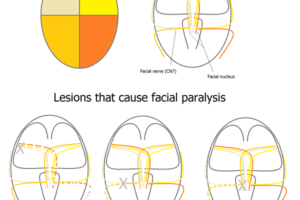The study of neurobiology covers a wide range of topics and disciplines, from neuroanatomy, to biophysics and electrophysiology, and systems biology. Each discipline has its own practices, but they combine to provide a basic description of the beautiful workings of the nervous system.
The nervous system controls almost every aspect of our body’s responses to the world. Central to this control is the flow of information from the sensory periphery through the central nervous system and back out to the periphery. As a general introduction to the nervous system let’s follow (at a very simplified level) the effects of seeing an old flame at your 10 year high-school reunion:
Let’s say you hear his/her voice before you see them:
– Mechanosensors in the ear split the voice into many auditory channels, each carrying a narrow range of sound frequencies. The auditory nerve carries the information in these channels to nuclei in the brainstem that calculate the location of the sound source. The information is then relayed to the thalamus, where a decision is made whether to send it on up to your cerebral cortex or to let it dissipate. If it passes on to your auditory cortex, the information gets processed and passed onto higher cortical areas as well as to “subcortical” (that is, not in the cerebral cortex) areas.
One subcortical area is the superior colliculus, that along with other areas, coordinates the rapid movement of your eyes. The superior colliculus orients your gaze to the sound source – you have now spun to check him/her out.
– Photopigments in the eye break contrasting color regions in the image into different neuronal streams in the retina, and the retinal neurons project through the optic nerve to the thalamus. Again, at the thalamus the information is either blocked (which would happen if you were asleep) or allowed to pass on up to the visual cortex. The image is initially parsed into tiny segments – in which color, orientation and brightness are encoded by the activity of individual neurons. The primary visual cortex projects to higher visual areas, each combining the input from the previous area into a more complex and larger representation. Eventually the information gets to your inferior temporal lobe and fusiform face area, in which complex features, like faces, are encoded. It’s him/her (the example would be much more compelling if I knew the interest of the reader).
– At this point information is starting to make its way to the frontal cortex, where executive decisions and value judgments are made. Did I lose enough weight on my diet to talk to him/her? Should I play it cool? What is my spouse going to say when he/she realizes who I’m looking at? and so on.
– The decision is made – play it cool and turn back around.
– Just then, that old perfume/cologne makes its way onto your nasal epithelium. Again the stimulus, this time a complex set of odorants, activates a unique set of receptors, each encoding a small range of chemical structures. The olfactory input, unfortunately, goes directly to olfactory cortex – which is primitive and bypasses the thalamus. The olfactory cortex plugs directly into the limbic system, which controls emotions.
– Your decision to play it cool, well reasoned as it was, has been over-ruled.
– The limbic system plugs into the hypothalamus, which controls your body’s homeostasis. Your hypothalamus is being bombarded by potent signals and it starts to activate your autonomic nervous system – your eyes dilate and the blood flow to your intestines shuts down, peripheral vascular tone decreases (your cheeks flush, your ears turn red).
– All these systems feed into associational areas in the cerebral cortex, which, now that the decision to speak has been made, send signals to motor areas. Primary motor cortex will control how your body and arms move around to face the subject of interest, your superior colliculus will control gaze direction, and Broca’s area will determine motor outputs of speech.
– Motor commands, descending from primary motor cortex through midbrain and pons send copies of the motor command to the cerebellum, which is in charge of making sure commanded motions match actual motions. In this case, unfortunately, your cerebellum is a bit slow because of the open bar, and as you turn to speak to him/her you spill your drink (a pink frozen daiquiri) all over your shirt.
– He/she smirks and turns away. Now you’re left to deal with much higher cortical functions – like how to get out as fast as possible.

